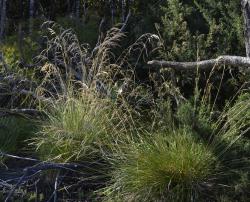- Taxon
- Gallery
- ≡ Aira cespitosa L., Sp. Pl. 64 (1753)
- = Aira australis Raoul, Choix Pl. Nouv.-Zél. 12 (1846)
- = Deschampsia penicillata Kirk, Trans. New Zealand Inst. 27: 354 (1895)
- = Deschampsia cespitosa var. macrantha Hack. in Cheeseman, Man. New Zealand Fl. 876 (1906)
Stiff, yellow-green, sometimes bluish green leafy tufts or strong tussocks, 30–120 cm, with rigid panicles on erect culms often well overtopping leaves. Leaf-sheath subcoriaceous, keeled, glabrous, faintly ribbed. Ligule 2.5–7 mm, striate, sometimes almost keeled, acute. Leaf-blade (3)–5–45 cm × 2–3.5 mm, flat, stiff, sometimes folded or inrolled, abaxially smooth and shining, adaxially ribbed, ribs scabrid, tip acute, subpungent. Culm erect, or slightly geniculate at base, internodes glabrous. Panicle (3)–10–30 cm, ± erect, lax at anthesis, bearing spikelets near branchlet tips, later more contracted; rachis and branches sparsely to moderately, finely scabrid. Spikelets (3.5)–4–7 mm, yellow-green to brownish or purplish. Glumes ± equal, slightly overtopping or equalling florets, rarely overtopped by florets in 3-flowered spikelets, acute, keel often very sparsely scabrid; lower 1-nerved, upper 3-nerved. Lemma (2.3)–3–5 mm, oblong, often sparsely scabrid above, apex 4-toothed, margins in upper ½ finely scabrid; awn (0.5)–1–4 mm, fine, straight, minutely scabrid, insertion middorsal or ± basal or rarely in upper ⅓, slightly overtopping or ± reaching lemma apex, occasionally ± appressed to lemma and not reaching apex. Palea narrower than lemma, apex bifid, keels and margins in upper ½ finely scabrid. Callus hairs to 1.5 mm. Rachilla hairs to 2 mm, dense, silky. Anthers (0.8)–1.2–2.2 mm. Gynoecium: ovary c. 0.8 mm; stigma-styles c. 1.5 mm. Caryopsis 1.2–1.6 × 0.4–0.7 mm. 2n= 26.
[From: Edgar and Connor (2000) Flora of New Zealand. Volume 5 (second printing).]




